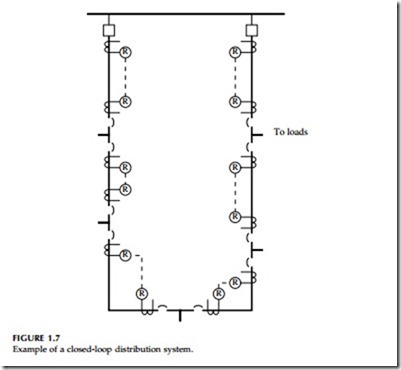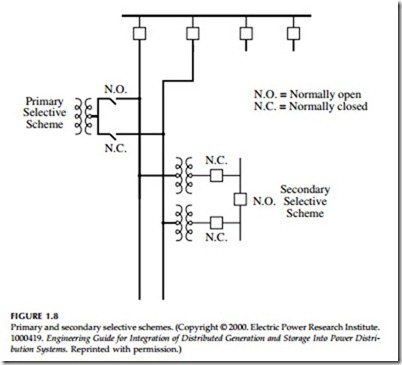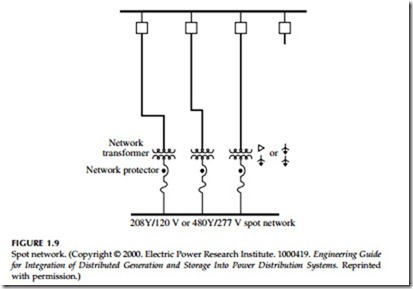Urban Networks
Some distribution circuits are not radial. The most common are the grid and spot secondary networks. In these systems, the secondary is networked together and has feeds from several primary distribution circuits. The spot
network feeds one load such as a high-rise building. The grid network feeds several loads at different points in an area. Secondary networks are very reliable; if any of the primary distribution circuits fail, the others will carry the load without causing an outage for any customers.
The spot network generally is fed by three to five primary feeders (see Figure 1.9). The circuits are generally sized to be able to carry all of the load with the loss of either one or two of the primary circuits. Secondary networks have network protectors between the primary and the secondary network. A network protector is a low-voltage circuit breaker that will open when there is reverse power through it. When a fault occurs on a primary circuit, fault current backfeeds from the secondary network(s) to the fault. When this occurs, the network protectors will trip on reverse power. A spot network operates at 480Y/277 V or 208Y/120 V in the U.S.
Secondary grid networks are distribution systems that are used in most major cities. The secondary network is usually 208Y/120 V in the U.S. Five to ten primary distribution circuits (e.g., 12.47-kV circuits) feed the secondary network at multiple locations. Figure 1.10 shows a small part of a secondary network. As with a spot network, network protectors provide protection for faults on the primary circuits. Secondary grid networks can have peak loads
of 5 to 50 MVA. Most utilities limit networks to about 50 MVA, but some networks are over 250 MVA. Loads are fed by tapping into the secondary networks at various points. Grid networks (also called street networks) can supply residential or commercial loads, either single or three phase. For single-phase loads, three-wire service is provided to give 120 V and 208 V (rather than the standard three-wire residential service, which supplies 120 V and 240 V).
Networks are normally fed by feeders originating from one substation bus. Having one source reduces circulating current and gives better load division and distribution among circuits. It also reduces the chance that network protectors stay open under light load (circulating current can trip the protectors). Given these difficulties, it is still possible to feed grid or spot net- works from different substations or electrically separate buses.
The network protector is the key to automatic isolation and continued operation. The network protector is a three-phase low-voltage air circuit breaker with controls and relaying. The network protector is mounted on the network transformer or on a vault wall. Standard units are available with continuous ratings from 800 to 5000 A. Smaller units can interrupt 30 kA symmetrical, and larger units have interrupt ratings of 60 kA (IEEE Std.
C57.12.44–2000). A network protector senses and operates for reverse power flow (it does not have forward-looking protection). Protectors are available for either 480Y/277 V or 216Y/125 V.
The tripping current on network protectors can be changed, with low, nominal, and high settings, which are normally 0.05 to 0.1%, 0.15 to 0.20%, and 3 to 5% of the network protector rating. For example, a 2000-A network protector has a low setting of 1 A, a nominal setting of 4 A, and a high setting of 100 A (IEEE Std. C57.12.44–2000). Network protectors also have fuses that provide backup in case the network protector fails to operate, and as a secondary benefit, provide protection to the network protector and trans- former against faults in the secondary network that are close.
The closing voltages are also adjustable: a 216Y/125-V protector has low, medium, and high closing voltages of 1 V, 1.5 V, and 2 V, respectively; a 480Y/277-V protector has low, medium, and high closing voltages of 2.2 V, 3.3 V, and 4.4 V, respectively.


